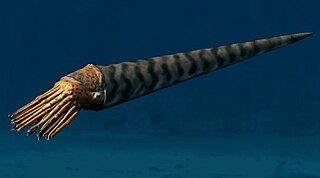The radula is an anatomical structure that is used by mollusks for feeding, sometimes compared to a tongue. It is a minutely toothed, chitinous ribbon, which is typically used for scraping or cutting food before the food enters the oesophagus. The radula is unique to the molluscs, and is found in every class of mollusc except the bivalves, who use instead cilia, waving filaments that bring minute organisms to the mouth.

Orthoceras is a genus of extinct nautiloid cephalopod restricted to Middle Ordovician-aged marine limestones of the Baltic States and Sweden. This genus is sometimes called Orthoceratites. Note it is sometimes misspelled as Orthocera, Orthocerus or Orthoceros.
The Bactritida are a small order of more or less straight-shelled (orthoconic) cephalopods that first appeared during the Emsian stage of the Devonian period with questionable origins in Pragian stage before 409 million years ago, and persisted until Carnian pluvial event in the upper middle Carnian stage of the Triassic period. They are considered ancestors of the ammonoids, as well as of the coleoids.

In political and social sciences, communism is the philosophical, social, political, and economic ideology and movement whose ultimate goal is the establishment of the communist society, which is a socioeconomic order structured upon the common ownership of the means of production and the absence of social classes, money, and the state.
Boletzkyida is a primitive order of teuthid coleoid cephalopod: the boletzkyids are thought to be the earliest forms of coleoid cephalopods, and appear to form a link between nautiloid orthocerids and more advanced coleoids. Boletzkyida was named and described by Bandel, Reitner, and Sturmer in 1983 (B.R.&S) from specimens found in the Lower Devonian black slate in Germany.

In geology, the Arenigian refers both to a time interval during the Lower Ordovician period and also to the suite of rocks which were deposited during this interval.

Sinoceras is an extinct genus of nautiloids from China included in the family Orthoceratidae that lived from the middle Ordovician until the Devonian. The type species, S. chinense, was originally described as a species of Orthoceras, but then moved by Shimizu and Obata to Sinoceras in 1935.
Rhabdiferoceras is an extinct genus of orthocerids belonging to the Baltoceratidae that lived in what would be North America during the Cassinian Stage at the end of the Early Ordovician, existing for approximately two million years from about 474 -472 mya.

Dinosaur Train is an American/Canadian/Singaporean children's animated series created by Craig Bartlett, who also created Hey Arnold! and Ready Jet Go!. The series features a curious young Tyrannosaurus rex named Buddy who, together with his adopted Pteranodon family, takes the Dinosaur Train to explore his time period, and have adventures with all kinds of dinosaurs. It is produced by The Jim Henson Company in association with Media Development Authority, Sparky Animation, FableVision, and Snee-Oosh, Inc. PBS Kids has ordered 11 more episodes, taking the total number of episodes to 100 which were planned to be released 2018, but has since been postponed to summer 2019.
Sphaeorthoceratidae is an extinct family of orthocone cephalopods that lived in the Paleozoic Era. They were similar to the nautiloid Michelinoceras in the apex, but had shorter necks to their septa that were orthochoanitic or suborthochoanitic.
Pleurorthoceras is an orthocerid cephalopod from the Upper Ordovician of North America. The shell externally is like that of Michelinoceras in being long and slender with a circular cross section. It differs in having a subcentral siphuncle with somewhat inflated segments.

The Independencia Formation is a Dapingian geologic formation of western-central Bolivia. The dark to bluish gray schists and phyllites metamorphosed shales were deposited in an open marine environment.
The Treatise on Invertebrate Paleontology published by the Geological Society of America and the University of Kansas Press, is a definitive multi-authored work of some 50 volumes, written by more than 300 paleontologists, and covering every phylum, class, order, family, and genus of fossil and extant invertebrate animals. The prehistoric invertebrates are described as to their taxonomy, morphology, paleoecology, stratigraphic and paleogeographic range. However, genera with no fossil record whatsoever have just a very brief listing.





